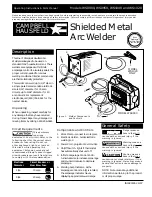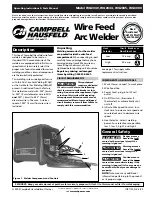
16
www.strata.co.nz
EZITIG 180
Weaving motion for
second and subsequent
runs
Pause at edge
of weave
Multi Run Vertical Fillet Weld (Fig
1-26)
Examples of Vertical Fillet Welds
(Fig 1-27)
Pause at edge of weave
allows weld metal to build
up and eliminates undercut
Note: Weld contour
when insufficient pause
at edge of weave
CORRECT
INCORRECT
2. Vertical Down
The E7014 Stick electrode makes welding in this posi-
tion particularly easy. Use a 3.2mm electrode at 100
amps. The tip of the electrode is held in light contact
with the work and the speed of downward travel is
regulated so that the tip of the electrode just keeps
ahead of the slag. The electrode should point up-
wards at an angle of about 45º.
The electrode is held at 45º to the horizontal and tilted
10º in the line of travel (Figure 1-28). The tip of the
electrode may be touched lightly on the metal, which
helps to give a steady run. A weave technique is not
advisable for overhead fillet welds.
Use a 3.2mm E6013 Stick electrode at 100 amps, and
deposit the first run by simply drawing the electrode
along at a steady rate. You will notice that the weld
deposit is rather convex, due to the effect of gravity
before the metal freezes.
Tilted 10
o
in
line of travel
Overhead Fillet Weld
(Fig 1-28)
Angle tacked to pipe
45
o
to plate
Use a short arc, and do not attempt to weave on the
first run. When the first run has been completed de-
slag the weld deposit and begin the second run at the
bottom. This time a slight weaving motion is neces-
sary to cover the first run and obtain good fusion at
the edges.
At the completion of each side motion, pause for a
moment to allow weld metal to build up at the edges,
otherwise undercut will form and too much metal
will accumulate in the centre of the weld. Figure 1-26
illustrates multi-run technique and Figure 1-27 shows
the effects of pausing at the edge of weave and of
weaving too rapidly.
3. Overhead Welds
Apart from the rather awkward position necessary,
overhead welding is not much more difficult that
down hand welding.
Set up a specimen for overhead welding by first tack-
ing a length of angle iron at right angles to another
piece of angle iron or a length of waste pipe. Then
tack this to the work bench or hold in a vice so that
the specimen is positioned in the overhead position
as shown in the sketch.
Other Knowledge
& Resources
Please refer to Euroquip website
www.euroquip.co.nz/ Downloads.html
for knowledgebase articles & operation videos.













































